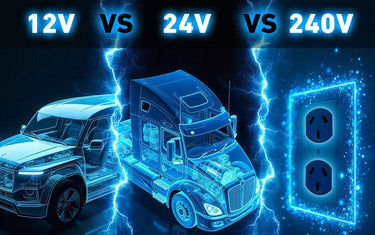When it comes to off-grid setups, camping gear or even just plugging in a fridge on the road, you’ve probably come across the terms 12V, 24V and 240V. But what do these actually mean? And why does it matter when choosing the right gear for your setup?
What Does “V” Mean?
“V” stands for volts – the unit used to measure voltage, or how much electrical pressure is being pushed through a circuit. Think of voltage like water pressure in a hose: the higher the pressure, the more energy is available to power a device.
Different voltages are suited to different applications – and mixing them up can damage your gear or create serious safety risks. So it’s important to understand what you’re working with.
12V Power – The Off-Grid Standard
12V DC (direct current) is the most common voltage used in vehicles, caravans, camper trailers, and 4WDs.
Your car battery, deep cycle battery, portable fridge, lights, fans, and most KickAss gear? All 12V.
It’s safe, efficient for short distances, and ideal for powering low-voltage accessories on the road.
Common 12V uses:
- Portable fridges and freezers
- LED lighting
- 12V fans
- Solar panels and battery setups
- Water pumps
24V Power – For Heavy-Duty & Commercial Setups
24V DC systems work exactly like 12V systems – but with twice the voltage. They’re often used in trucks, buses, and larger rigs that need more power or longer cable runs.
Because voltage is doubled, 24V systems can run more efficiently – with less current, lower cable losses, and better performance over long distances. But they require 24V-compatible gear.
Common 24V uses:
- Heavy-duty vehicles and trucks
- Larger off-grid solar systems
- High-output inverters and appliances
Important: You can’t plug a 12V appliance into a 24V system without a step-down converter – it will fry your gear!
240V Power – What You Have At Home
240V AC (alternating current) is your standard household mains power – the same type that comes from your wall sockets at home.
In a camping or off-grid context, you’ll usually get 240V power by using:
- An inverter (converts 12V or 24V battery power into 240V AC)
- A generator
- A powered site at a caravan park
240V lets you run high-wattage appliances like kettles, toasters, microwaves, air conditioners, and power tools – but it requires proper safety precautions and suitable cabling.
Common 240V uses:
- Mains appliances (kettles, air fryers, coffee machines, etc.)
- Charging power tools or laptops
- Household-style setups in caravans and RVs
DC vs AC – What's the Difference?
- DC (Direct Current): Used in 12V and 24V systems. Power flows in one direction. Best for batteries, vehicles, and solar.
- AC (Alternating Current): Used in 240V mains power. Power flows back and forth. Best for household appliances.
You’ll often need an inverter to convert from DC to AC, and a charger or power supply to go the other way.

Final Thoughts
Choosing the right voltage for your setup depends on what you're powering, how far your cables run, and what gear you already own.
- Sticking to 12V? Great for most off-grid setups.
- Running big gear or long cable runs? 24V might be the go.
- Need to run mains appliances? You’ll need 240V via an inverter or generator.
And if you’re still unsure, drop into one of our retail stores or give our team a call on (07) 3123 4715. We’re here to help.


































































































